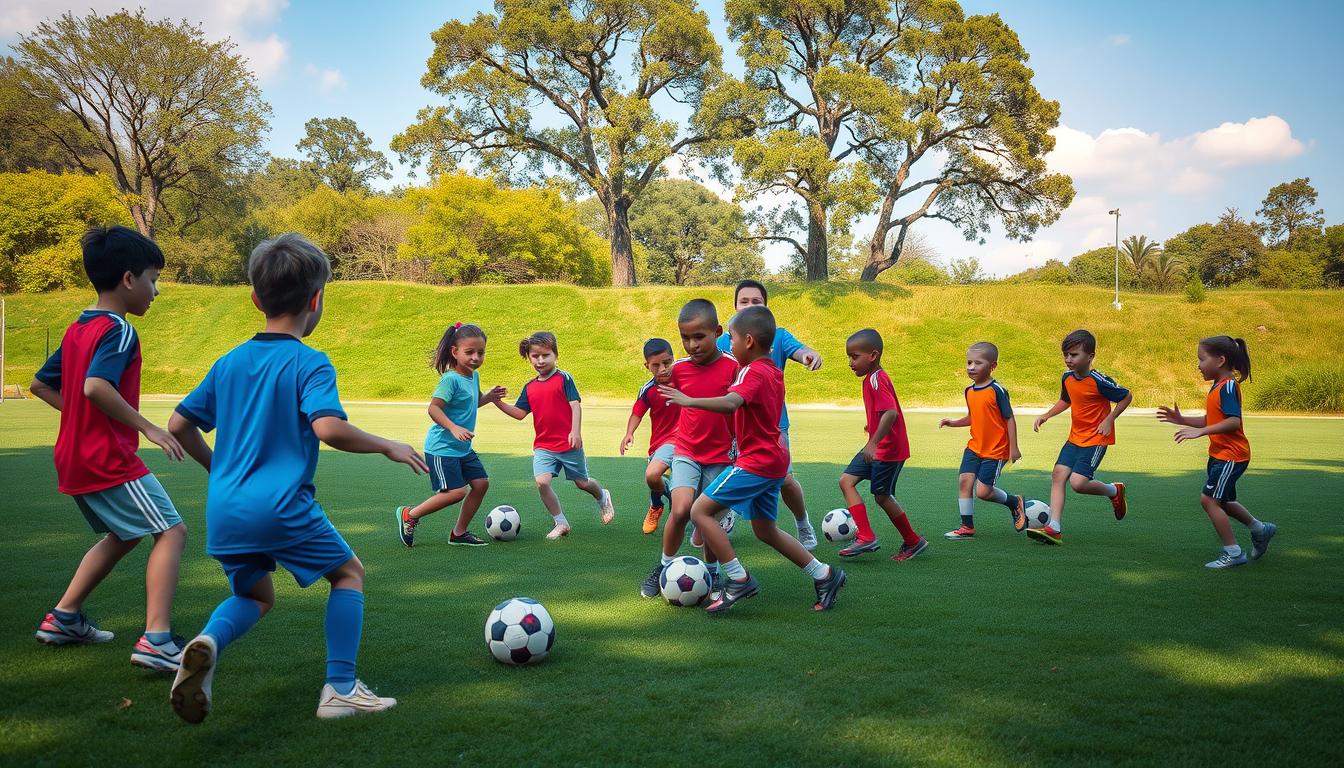How to Motivate Your Child in Soccer: Tips and Tricks

Watching young athletes grow their passion for soccer starts with understanding what drives them. Kids thrive when they feel joy in learning new skills and see progress in their game. For parents and coaches, creating a supportive environment that balances fun with structure makes all the difference.
This guide shares practical strategies to help your player stay engaged. Focus on celebrating small wins, mixing up practice routines, and setting realistic goals. You’ll discover how to turn setbacks into learning moments while keeping their confidence high.
Key Takeaways
- Intrinsic motivation grows when kids enjoy the learning process
- Varied training sessions prevent boredom and boost engagement
- Positive reinforcement builds lasting self-esteem
- Clear goals help track progress without pressure
- Collaboration between parents and coaches enhances results
Whether your child is new to the sport or aiming for club-level play, these methods work for all ages. Let’s explore how to make soccer a rewarding experience that keeps them excited to play.
Understanding Your Child’s Interest in Soccer
Every young player has unique reasons for loving the game. Some light up when dribbling past defenders, while others thrive during team celebrations. Recognizing these natural sparks helps create meaningful support systems.
What Drives Their Passion?
Intrinsic motivation comes from genuine enjoyment, not rewards or pressure. A child might beg to practice free kicks after dinner or replay game highlights unprompted. These are signs they’re hooked on the game itself.
Spotting Their Favorite Moments
Notice when they laugh during drills or bond with teammates. Research shows 78% of youth soccer participants stay engaged because of friendships and fun challenges. Did their eyes widen after scoring their first goal? That’s pure joy fueling growth.
| Motivator Type | Characteristics | Long-Term Impact |
|---|---|---|
| Intrinsic | Self-driven excitement | Sustained skill development |
| Extrinsic | Praise or trophies | Short-term engagement |
Tailor encouragement by asking questions: “What felt awesome today?” or “Which drill should we try next?” This approach keeps training fresh and aligned with their evolving interests. Watch how they respond – their energy will guide you.
Setting Clear and Achievable Soccer Goals
Clear objectives turn chaotic drills into stepping stones for success. When young players know exactly what to work on, they focus better and see tangible progress. Start by breaking down big dreams into bite-sized tasks that match their skill level.
Creating Simple Targets for Each Practice
Keep sessions productive with specific, measurable goals. For example:
- Complete 10 accurate passes in a row
- Dribble through cones without losing control
- Attempt three shots on goal from different angles
These mini-challenges make training feel like a game rather than work. A club director survey found teams using this approach saw 40% faster skill development.
Rewarding Effort and Improvement
Celebrate hustle as much as results. Did they finally nail that tricky footwork? High-five! Track progress visually with charts or sticker boards. Research shows recognition boosts effort by 63% in youth soccer programs.
Pair praise with constructive coaching: “Your passing accuracy improved – let’s try longer distances next!” For more youth soccer motivation tips, focus on what they control – attitude and attempts – rather than just goals scored.
Creating a Fun and Varied Training Environment
Transforming practice sessions into exciting adventures keeps young athletes hooked. A dynamic mix of structured drills and creative play helps children develop skills without feeling overwhelmed. Rotate activities every 15-20 minutes to match their attention spans.

Planning Engaging Drills and Sessions
Blend classic exercises with imaginative twists. Instead of standard passing drills, try “Zombie Defense” games where players protect their ball from “infected” coach taggers. Research shows kids retain 30% more footwork techniques through story-based training.
| Drill Type | Focus Area | Engagement Level |
|---|---|---|
| Obstacle Course Relay | Dribbling & Speed | High |
| Skill-Based Scrimmage | Teamwork & Strategy | Medium-High |
| Target Shooting Challenge | Accuracy & Power | Medium |
Mixing Up Routine Exercises
Swap traditional warm-ups for rhythm-based footwork to music. Use colored cones to create visual patterns for passing sequences. A youth soccer study found teams using varied drills improved 22% faster in technical skills.
End sessions with “free play” time where players invent their own games. This unstructured fun builds creativity while reinforcing learned techniques. Remember – laughter on the field often signals effective learning!
Effective Communication and Positive Feedback
Great coaching starts with words that lift spirits. When players hear specific praise like “Your passing vision improved today!” their confidence grows. Studies show children coached with smiles and upbeat tones report 89% better game experiences – even after tough losses.
Using Encouraging Language
Swap criticism for curiosity. Instead of “Don’t kick it that way,” try “Let’s practice angled shots together!” High-fives after saves or creative plays build trust. Coaches who focus on effort over errors help players embrace challenges.
Highlighting Progress and Strengths
Start post-practice chats with wins: “Your defensive hustle stood out today.” Track improvements visually – mark milestones on a club bulletin board. Research proves youth soccer athletes receiving weekly progress notes try 34% harder in training.
Parents and coaches should team up. Share observations like “Emma’s footwork improved” to reinforce growth. Celebrate small steps – mastered skills, better attitude, or helping teammates. This approach turns setbacks into comebacks.
How to motivate your child in soccer
Empowering young athletes to steer their soccer journey sparks lasting enthusiasm. When players shape their own experiences, they develop critical thinking and ownership of their progress. Start by offering choices during training – let them pick positions or design warm-up routines.
Letting Choices Drive Development
A child who selects their practice drills invests more effort in mastering them. Research shows youth soccer participants making autonomous decisions improve 25% faster in technical skills. Try these approaches:
- Allow position experimentation during scrimmages
- Create “captain’s choice” segments in practices
- Use video replays for self-assessment of game decisions
| Structured Approach | Independent Approach | Outcome |
|---|---|---|
| Coach-assigned roles | Player-chosen positions | +18% engagement |
| Fixed drill sequence | Custom practice mix | 33% faster skill gain |
| Adult-led analysis | Video self-review | Better retention |
Smart Support Systems
Parents and coaches can foster independence while providing safety nets. Ask open-ended questions: “What strategy worked best today?” instead of giving direct instructions. During games, let players solve problems before offering suggestions.
Balance freedom with gentle guidance by collaborating on goals. A team study found athletes setting 50% of their objectives showed 40% higher commitment. Celebrate creative plays and unexpected solutions – these moments build the resilience that fuels lifelong love for soccer.
Building Team Spirit and Community
A thriving soccer team does more than win matches – it shapes character through shared purpose. When players feel connected to their group, they push harder, celebrate louder, and bounce back faster. Studies show 82% of youth athletes perform better when trusting their teammates.
Fostering Strong Relationships with Teammates
Friendships off the field fuel chemistry during games. Plan bonding activities like:
- Pre-game team dinners with fun trivia
- Partner drills that pair different skill levels
- Group celebrations for assists as well as goals
These things build trust – critical for seamless passes under pressure. A University of Michigan study found teams with strong social ties completed 28% more successful plays.
Connecting with Coaches and Club Leaders
Open communication channels help everyone align goals. Encourage players to ask coaches specific questions like, “What’s one way I can improve my defensive positioning?” Attend club meetings to understand training philosophies.
Parent-coach check-ins every 3-4 weeks keep expectations clear. Share observations like, “Jamal feels more confident in midfield lately” to reinforce progress. This teamwork between families and staff creates a united support system.
When the whole group invests in collective success, challenges become stepping stones. Team camps or volunteer events deepen connections beyond routine training. Remember – a connected team outlasts any scoreboard.
Wrapping Up Your Soccer Journey
Success in youth soccer shines through growth, not just scoreboards. Building skills and confidence takes clear goals, creative training, and unwavering support. Celebrate every pass mastered and new move tried—these moments fuel long-term passion.
Strong communication between players, families, and coaches creates a winning environment. Let young athletes lead sometimes—choosing drills or solving game challenges builds critical thinking. Every match teaches something valuable, whether a win or a tough loss.
Keep practices fresh with effective drills that mix skill-building with fun. Track progress through effort and attitude, not just goals scored. Over time, these habits build resilience that translates beyond the field.
The journey matters most. Cheer loud, stay positive, and watch how soccer skills become life skills. Your support helps them thrive at every level—today’s practices shape tomorrow’s leaders.
